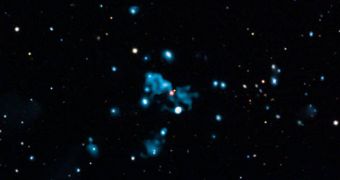Astronomers observing the skies with NASA's Chandra X-ray Observatory recently discovered one of the most peculiar formations in the Universe, and the first one of its class ever to be found, an X-ray source that existed about three billion light-years after the creation of the Universe, and was located some ten billion light-years away. While not spectacular in itself, the strange formation could give researchers more thorough insight into the type of events that were going on in the early Universe.
The huge source, most likely the direct result of a black hole explosion, was dubbed HDF 130, and was determined to have lived in a time when the Cosmos was producing galaxies and black holes at a frantic pace. According to the figures supplied by Chandra, the radiation source span 2.2 million light-years, and is shaped somewhat like a cigar. Basically, the experts say, after the black hole had a massive outburst, blowing with the power of about one billion supernovae, all radiation faded away over time, and only the present diffuse source of X-rays remained.
“We'd seen this fuzzy object a few years ago, but didn't realize until now that we were seeing a ghost. It's not out there to haunt us, rather it's telling us something – in this case what was happening in this galaxy billions of year ago,” Cambridge University expert Andy Fabian, who is one of the scientists that was involved in the discovery, explained.
According to the researcher, the formation was generated by a very strong outbreak from the supermassive black hole nearby, which must have emitted streams of super-energetic particles from its poles, at nearly the speed of light. The faint X-ray signature that it still presents today is only a shadow, or “ghost,” of the real-life event, which must have affected solar systems, stars, cosmic gas, dust and other celestial bodies on a wide range.
“This ghost tells us about the black hole's eruption long after it has died. This means we don't have to catch the black holes in the act to witness the big impact they have,” team member Scott Chapman explained. “This result hints that the X-ray sky should be littered with such ghosts, especially if black hole eruptions are as common as we think they are in the early universe,” another member of the team, Caitlin Casey, concluded. Both researchers are from Cambridge University, Space informs.

 14 DAY TRIAL //
14 DAY TRIAL //